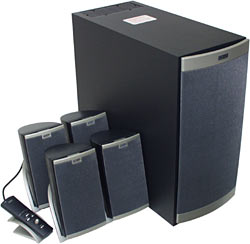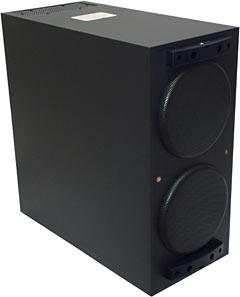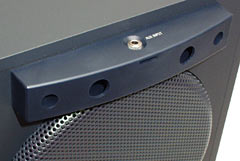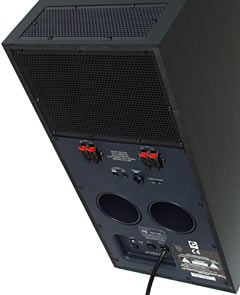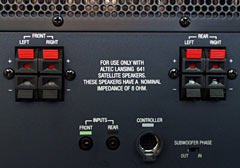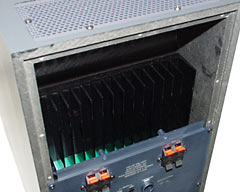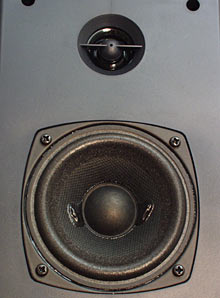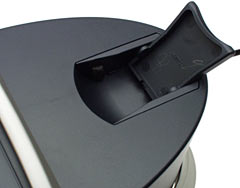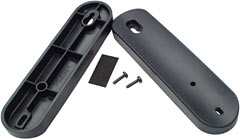
Altec Lansing Select 641 multimedia speaker system
Review date: 15 March 2002.Last modified 03-Dec-2011.
The Quest for Bass is, generally, a futile one, if you're shopping for computer speakers. Computer speaker systems without subwoofers aren't in the race at all; computer speaker systems with subwoofers almost always don't have a big enough one.
Sorry, but you just can't get deep bass out of a "subwoofer" the size of three stacked tissue boxes.
You can physically fit a quite serious bass driver in a very small box, but that doesn't do you any good. If such a box is sealed (an "acoustic suspension" enclosure), it'll contain so little air that the bass driver can't move far without the pressure change in the box greatly restricting further movement. So the driver won't be able to deliver bass anywhere near as low as you'd think, looking at its specifications; the lower the frequency at a given volume level, the further the speaker cone has to move. Low bass therefore ain't gonna happen, while there's a very springy small air volume on one side of the driver.
If a tiny sub box is ported (a "bass reflex" enclosure), as practically all computer speaker subwoofers are, it'll also need to be quite large if you want low bass. That's because it has to contain an air volume matched to the resonance of its bass driver(s) and port(s).
You couldn't even fit a proper subwoofer port in most "multimedia speaker" subs, much less the rest of the air space the thing'd need for proper bass.
There are, however, some not-too-expensive multimedia speakers that do manage quite solid bass. And reasonable midrange and treble sound quality, too. Such speaker systems don't have a small subwoofer, but that's not a big deal, because subwoofer positioning is flexible. Bass frequencies aren't directional. As long as the speaker system controls aren't on the sub box, you can therefore tuck it somewhere out of the way.
Not anywhere; room resonances and the driver and port locations on the box mean that there are lots of subwoofer positions and orientations, in any normal room, that'll cause the sub to not work properly. But there are still lots of options; even in small-ish listening rooms, you can generally find a suitable home for even quite a big sub.
Speaking of which, here one is.
Altec Lansing's Select 641 speaker system is pretty basic in concept. It's a 4.1 speaker system - four satellites, one subwoofer. It doesn't have a centre speaker, or any fancy surround decoding hardware on-board; if you want surround, your sound source will have to provide it. This thing's just the five boxes and a wired remote, so you don't have to learn to turn the 641 on and off with your toe. Its Australian list price is $AU499; in the States, the 110 volt version is already selling for about $US170, ex shipping, from reputable dealers.
I checked out Altec Lansing's Select 4100 system in my speaker comparison here. That system bears a definite family resemblance to the Select 641. But the 4100 is, by comparison, the small and weedy member of the family who gets bullied at school.
The 641 is the large and hairy member of the family who, later, plays the pinata game with the bully.
The 4100 has a ported subwoofer with twin 5.25 inch drivers, and a 70 watt system power rating. The 641 sub has the same layout, but its drivers are 6.5 inch units (well, maybe only 6 inchers, but let's be generous), and the system power rating is 200 watts RMS.
You have to look in the small print to find that number, by the way; the advertised "Total System Power" is 400 watts. But that's just the usual pumped-up fake power rating, which pretty much every multimedia speaker maker feels obliged to put on the outside of the box. Don't worry about it. The Select 641's amplifiers are not underpowered, and its speakers are not inefficient.
The big deal about the Select 641 is its subwoofer. Here it is without its cloth front panel. The two drivers are protected by steel grilles, so it's actually harder to damage if you leave the front panel off. The cloth panel's the wimpiest thing about this box.
The last really grunty multimedia speaker system I looked at was Logitech's Z-560 rig, reviewed in the same comparison as the Select 4100. The Z-560 sub has a single eight inch driver, and its outside dimensions, not counting the chunky heat sink sticking out of the back, are about 28 by 28 by 33cm (11 by 11 by 13 inches).
That's big by multimedia speaker standards, but the Select 641 sub's bigger. It's about 21cm wide by 46cm high by 44cm deep (8.25 by 18.1 by 17.3 inches), not counting the front grille.
This sub's about the size of a midi-tower PC, basically. But heavier.
By multimedia speaker standards, this sub is a giant.
At the top of the front of the sub there's a 1/8th inch auxiliary input jack. Like the aux input on other Altec Lansing 4.1 channel systems, this input doesn't have its own channel; it just plays through the front stereo channel and subwoofer, on top of anything else that's playing through the standard inputs. It's an easy way to connect a personal stereo or similar temporary input, though.
The sub's cloth front panel is packed separately in the Select 641 box; you need never put it on at all if you prefer the steel-grille look.
The front panel I got was, actually, rather difficult to attach; the pegs on the panel didn't quite match the holes on the sub. Once on, though, it fit OK, and didn't rattle.
The actual box volume of the Select 641 subwoofer isn't as large as you might think, because the last three-odd inches of its depth is just a shroud for its electronics module and heat sink. The heat sink isn't as hefty as the one on the Z-560, but the Logitech sub's sink is overkill, really.
The 641 heat sink gets its air flow through two steel grilles at the top of the back of the box.
The 641 sub has a plain bass reflex cabinet, like the Z-560 one, but it's got enough depth that it doesn't need to do curvy-port tricks like the Logitech product. Instead, there are two straight ports, with an inside diameter of about 65mm (2.5 inches), and a length of a bit more than 30cm - almost exactly one foot, actually. There's no flaring or lagging material on the ends of the ports, which means they'll "chuff" noticeably at peaks in the sub's response, behaving like big bass whistles. Sharp-edged ports are easier to design, but they don't sound as good as a well-designed smooth-edged one.
The rear connectors on the sub are easy enough to deal with. The satellite speakers have plain figure-eight-wire cables, which means it's possible to connect them backwards to the spring terminals on the back of the sub, and mess up your sound. All of the cables have a red marker on the positive wire, though, so it's not hard to get it right.
The input terminals are a pair of normal 1/8th inch stereo jacks, as used on sound cards, and there's a mini-DIN socket for the remote control cable. There's also, unusually, a subwoofer phase switch, which you can use to reverse the bass polarity (cone moving out when it normally moves in) if you've positioned the sub in such a way that reverse phase works better.
You get a couple of 1/8th inch stereo plug leads with the system, plus a short twin RCA socket to 1/8th inch socket lead. This lets you connect anything with plain stereo RCA output - game consoles, home audio equipment - to the Select 641, provided you've got a normal male-to-male stereo RCA lead as well.
With the rear grille removed, the wonders of overexposure let you vaguely see the heat sink inside. I like this arrangement; it lets the heat sink get reasonable air flow, without leaving its pointy fins sticking out where they can get damaged or, more plausibly, damage you.
It's easy enough to remove the back panel of the sub, but that's as far as my attempts to dismantle it went. Taking the back off just lets you look at the bit of the electronics module that sticks out of the cabinet proper; undoing all of the electronics module screws and then seeing if it was possible to disconnect its hook-up wires, get it out of the way, and take pictures of the innards through the small hole thus created, sounded too much like hard work to me. The front panel of the sub is permanently attached, the sub drivers are screwed in from the inside, and the ports are glued in place as well as screwed.
There was nothing stopping me shoving a flashlight down one port and feeding an inspection mirror down the other, though, so I did. Inside, the sub box is braced and lightly lagged, and the drivers have hefty magnet assemblies, about 10cm (four inches) across. As you'd want 'em to, since the bass drivers handle most of the power in any speaker system, and getting most of an alleged 200 watts out of a pair of mere 6.5 inchers is something of an achievement.
On the back of the bass drivers is printed just the Altec Lansing brand, the four ohm nominal impedance, and a couple of cryptic numbers. These drivers aren't polite enough to advertise their real rated power handling, like the driver in the Z-560 sub.
Ignoring the power handling issue for the time being, though, a pair of 6.5 inch bass drivers has about 66.4 square inches of piston area. That's rather more than you'll get from a single eight inch driver like the one in the Z-560 sub, but less than you'll get from a single ten inch, like the drivers you'll find in many mid-quality home theatre subwoofers.
Cone area determines air moving capacity for a given cone excursion, but cone diameter is linked to the excursion a speaker can manage at a given frequency. All other things being equal, a pair of 6.5s can therefore be expected to give roughly the same bass performance as a single eight.
The four Select 641 satellites are identical, except for the length of the cables. The rear speakers have about five metres of wire, the front ones about three. If you need more cable length, anybody with a soldering iron can easily graft on more wire.
The Select 4100 system's satellites look great, but use a couple of tiny one inch drivers, and have a tendency to fall over backwards with very little provocation. The Select 641 satellites have the same swoopy cast-aluminium stand design as the 4100 ones, but are otherwise more conventional - sealed plastic boxes with curved backs (which helps somewhat to reduce box resonances, but in multimedia speaker satellites is basically just a cosmetic feature) and removable cloth grilles.
Altec Lansing call the larger drivers in the satellites three inchers, but that's being too generous. They've got 2.5 inch cones, tops. This isn't an unusual size of driver for multimedia speaker satellites, but it's really too small for decent low midrange response. Still, these satellites have impressive heft, thanks to substantial magnet assemblies on the backs of the 2.5 inch drivers; I've seen plenty of worse widerange speakers.
Helping out with the high frequencies is a one inch tweeter, behind a sculpted protective bar that gives them a wee bit of horn coupling to the air, improving their efficiency.
The 641 satellite cabinets naturally aim upwards, which is usually what you want from your computer speakers, since they're likely to be sitting on your desk. If you're setting them up at ear level, though, you'll want them to shoot straight forward. No problem; they've got a flip-down foot at the back.
Inside the satellites, there's not much to see. More anonymous drivers, a capacitor in-line with the tweeter to serve as a rudimentary crossover, and a metal lid over the opposed magnets on the back of the 2.5 inch driver. Back-to-back magnets are what provide the drivers' magnetic shielding, allowing you to put the satellites near a CRT monitor without distorting the image.
The double magnets are part of the reason why the satellites are satisfyingly heavy, but there are lots of lighter shielded speakers than this. So these little drivers still ought to have reasonable power handling.
There's also tape holding the driver wires in place, to stop them buzzing against things inside the box. That's good. But there's no lagging material, to damp resonances and improve the satellites' bass response a bit. That's bad. But common.
The speaker wire going into the satellites is glued in place. So if you trip over the cable and break a conductor or two, you'll need a soldering iron, a hobby knife and a hot-melt glue gun as well as a screwdriver to make things good with new cable.
The Select 641 comes with these two brackets (and screws, and little stick-on foam things) to allow you to hang a couple of satellites on the wall if you like. You just unscrew the stand and screw on the bracket, and then drive another screw into the wall to hang the speaker.
The remote that comes with the Select 641 looks and works the same as the one for the Select 4100. It's an elegant little item, which hooks into a cast aluminium stand, or can be held in your hand. There's one button for power, and one knob that controls volume or bass or treble depending on which of two other buttons you've pressed (it reverts to volume if you leave it alone for three seconds). The one other button on the remote lets you switch between Stereo mode (subwoofer and front speakers only), Stereo X2 mode (front input doubled to the rear channels), and Gaming mode (surround mode, with rear speakers active but only doing anything if there's input on the rear channel). Green LEDs tell you about the settings.
As with the Select 4100, the remote has a headphone socket on the top of it; plug in your 'phones and the speakers are muted.
Listening tests
I much prefer reviewing cheap and nasty speakers. They're not only easier to carry, but they also don't give you a headache.
The Select 641 can play loud. Party-volume loud. I don't know whether it's louder than the Z-560 or not; they're both much louder than I need, when I'm not in a Billy Thorpe sort of mood.
I've got my doubts about the actual power rating of this system, but it clearly has, to use the term that Rolls-Royce Motor Cars Limited used to use about their engines, "sufficient". Maximum power rating really doesn't matter; 200 watts only sounds about 15% louder than 100, thanks to the logarithmic response of the ear. You need a thousand watts to get twice as loud as 100.
The Select 641 can also play low. Very low, by computer speaker standards. The actual in-room response curve is all over the place, with resonances-a-go-go from the sub box and the room itself, but this sub is still quite strong at 80Hz, and does something noticeable all the way down to about 40Hz. It dribbles away to nothing below about 35Hz.
This isn't the 27Hz bass response that Altec Lansing cheerfully claim, but it's only about five semitones above it, which is a much smaller fib-factor than usual. It might get even closer in a big listening room.
As usual, though, Altec Lansing give themselves an out by not bothering to specify how attenuated the bass is meant to be at 27Hz. The speaker in your telephone has response at 27Hz, but it's down about a zillion decibels from its real low end limit.
As is normal for cheap subwoofers - all computer speaker subs are cheap subwoofers, in case you were wondering - the Select 641's bass is boomy and ill-defined. It's a heck of a lot better than the bass from the piddly four-inch-driver things that pass for subwoofers on most multimedia speaker systems, and it doesn't buzz or clip offensively unless you're being particularly silly with your source material, volume and bass settings. But if you're listening to something with fine bass detail... well, you won't know it.
Considering the price, though, it's great.
For boom-tish-boom-tish music, the Select 641 sub is excellent. For game explosions and low frequency effects in the less subtle sort of movie, it gets the job done. For thud-and-blunder organ music, it shakes things off shelves quite satisfactorily.
For lighter music, it's not so wonderful, because this sub sings much too loudly in the low midrange. Real subwoofers shouldn't make a sound above about 80Hz; multimedia speaker subs almost all play much higher, perfectly happily. The 641 sub gets well up into the range of various orchestral instruments besides the timpani, and so it makes obnoxious noises when you're listening to music featuring such instruments, if there aren't pipe organs or earthquakes to drown them out.
Multimedia speakers don't have to do this; the cheap Hercules rigs I reviewed recently here don't. But most do, and the Select 641 does too. It's presumably to prop up the questionable low-mid response of the drivers in the satellites. That doesn't make it right, though.
When you find yourself hearing the sub in ways you'd rather not, you can of course just tweak the bass down, which delivers an OK result with this system; the times when the sub's high response becomes annoying are usually not the times when you want lots of bass. And the Select 641 is far from the worst offender I've heard in this area. But real subwoofer aficionados will sneer at it.
Any sub that can emit some reasonable amount of energy at 50Hz and below - as the Select 641 one can - will be able to create nasty noises in pretty much any listening room, if you position it wrongly. For instance, at certain frequencies, it's possible to excite the room's own resonances in such a way that if you're sitting in the right (or wrong, depending on how you look at it) place, you can then end up hearing oppositely phased bass in each ear. And you'll strangle the bass completely if you point the ports or the drivers at a nearby wall. This is not an especially fussy sub, though; not a lot of experimentation should be needed to get it sounding OK, even if you don't feel like fooling with the phase switch on the back.
The Select 641 satellites didn't knock my socks off, but neither did they make plasticky resonant noises, sound as if they were trapped in a pillow case, or tizz away annoyingly at the top of their range. They work. They'd probably be unacceptable if they didn't have the tweeter; the widerange drivers in the Z-560 satellites are rather more exotic than the ones in the 641 sats. But the 641 sats do have a tweeter, and they sound OK to me.
Overall
The Select 641 system sounds very good indeed for the kind of program material it's likely to have to deal with, considering its reasonable price.
That said, if you listen to the Select 641, or the Z-560, or any of the other few genuinely bassy computer speaker systems out there, and think you now know what a Proper Subwoofer sounds like, you're wrong.
Proper subs have more bass extension than the 641 sub, and far better bass clarity. Set a proper sub up correctly and you'll have no idea where it is. And there'll be no point in the frequency range where the bass goes muddy.
You're not going to get a quality powered subwoofer for less than about $AU1000, though. A Sonique Thunderbox 1200 (Sonique are Australian, and possessed of a robust sense of humour), for instance. More money will get you more and better bass; $AU1500 will buy you something with some real poke. And you can spend far more again, if leaving no window uncracked is your goal.
Getting back to earth, though - even at the full retail price, you can get a pair of whole Select 641 systems for the price of a decent powered home theatre sub.
The Australian list price for the Select 641 is the same as the list price of the Logitech Z-560. The two systems have similar overall specifications.
The Z-560 has, I think, marginally better satellite speakers (with proper screw terminals, not integrated wires), and a stereo expander circuit that sounds quite nice, and which the Select 641 lacks.
The 641 subwoofer, however, may actually be even better than the Z-560 one. The Z-560 sub is loud as all get-out - too loud, even with the bass knob turned down, for some material - and plays far deeper than most multimedia subs. But I harbour a suspicion that the 641 sub plays lower. It's a close-run thing, though; you'd really want to listen to the two of them next to each other.
Both of them play too much low-midrange through the sub, so there's nothing in it there.
There exist in the world people who can use phrases like "121 dB SPL at 10 Hz is very nice" without irony.
Note: The "threshold of pain" line is often set at 120dB, but if you're not listening to anything above 50Hz at that sound pressure level, then it's probably just the threshold of incontinence.
If you're one of these people, no multimedia speaker system will satisfy you.
Similarly, if you're into bass quality above bass quantity, the bulk mudslide bass of a cheap sub will annoy you.
But if you just want a medium fidelity surround speaker system for your computer or other line-level source, and you don't want to drop more than about $AU500 on it, the Select 641 and the Z-560 are both excellent options.
I really can't decide between them, personally. But the Select 641 still gets a "Recommended" from me.
